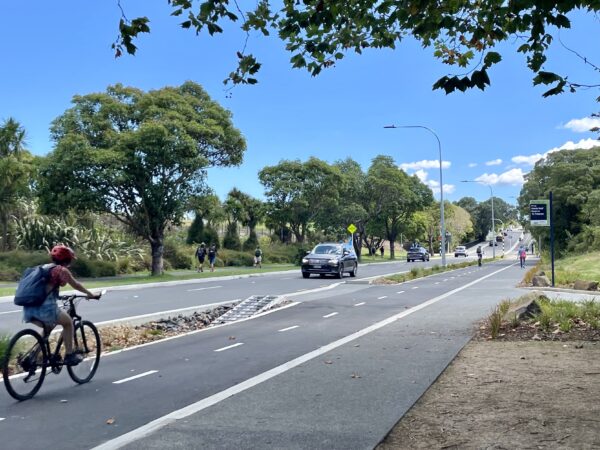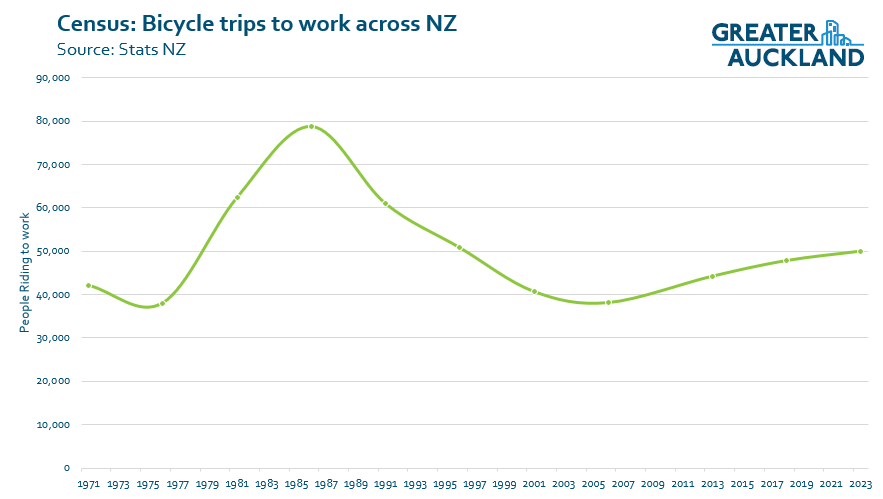The media’s tendency to seize on anything bike-related and turn it into a scandal took a new turn this week, after it was revealed David Seymour, in his role as Minister for Regulation, had asked for advice about removing the mandatory helmet requirements for people on bicycles. Newstalk ZB reports:
Minister for Regulation David Seymour asked his ministry for advice about the benefits of removing cycling helmet requirements, Newstalk ZB can confirm.
The Ministry for Regulation told Seymour the risks of removing the requirements would outweigh any benefits, and it was determined no further action was taken.
Documents on the matter have been released to Newstalk ZB under the Official Information Act, including advice which warned that removing the helmet mandate would lead to more deaths.
A regulatory response issue, sent to Seymour’s senior ministerial advisor from the Ministry for Regulation, went into depth about the current requirements. It confirmed his office asked for advice about “the potential risks and benefits of removing the requirement for helmets to be worn on bicycles”.
Bike helmets have been mandatory in New Zealand since 1994. Not wearing one carries a fine of $55.
Data quoted by the Ministry for Regulation found following that mandate, adult helmet use in New Zealand rose from 43% in 1993 to 92% the year after.
Initial analysis undertaken by the ministry recommended the risks of removing bike helmet requirements outweighed any benefits, with Seymour provided numerous reasons as to why.
Ministry officials first pointed out it did not believe there would be a material increase in the uptake of cycling by removing the bike-helmet mandate. The document stated that while cycling has declined since the 1990s, several factors including increased car ownership, urban planning and a lack of cycling infrastructure contributed to this.
Stuff took a more incredulous tone, asking where this might end; perhaps not unreasonable, given the ACT party’s approach to other health and safety policies, including those that keep road workers safe.
Will he look into getting rid of seatbelts in cars? What about aircraft safety briefings? We ask how far is too far for the Regulation Minister’s red tape crusade.
New Zealand is one of only a handful of countries with mandatory cycilng helmet laws for people of all ages. While I’m far from a fan of David Seymour, it is curious that he’s getting this attention for asking the question, especially given he’s accepted the suggestion from officials that the regulation is worth keeping.
However, the information in the report released by ZB does raise some questions about the type and quality of the advice he received.
The issue of fatalities and severe head injuries was also raised by the Ministry for Regulation, which stated helmets are “generally low cost and highly effective at preventing serious injury and death from cycling accidents”.
“There has been a significant decline in serious injuries and fatalities since a regulatory helmet mandate was introduced in New Zealand,” the advice read.
“The ministry considers that removing the helmet mandate would likely lead to an increase in serious injuries and fatalities as a result of cycling accidents. As well as personal, family and societal costs, this would lead to increased healthcare and long-term ACC scheme costs. As outlined above, we do not think there would be any material benefits‚” officials said.
Data was provided which proved cycling helmets had been “consistently shown to be effective” in reducing the severity of head injuries.
Since helmets were mandated in New Zealand, it was found the number of serious injuries and fatalities both decreased markedly.
A 62% reduction deaths and 57% decline in serious injuries is obviously very much a good thing. But the glaring hole in that analysis is that across that period, the rate of people cycling declined significantly too.
Getting a full picture of how many people cycle can be hard, but even with the few solid data points we do have, the decline in cycling for everyday transport has been significant, and goes hand in hand with a rise in driving and the number of cars on the road. It’s a vicious circle: the riskier it feels to ride a bike, the less people do so – and of course the opposite applies as well.
Census data shows the number of people who said they rode to work peaked in 1986 at just under 79,000, and by 2006 this reached a low of just 38,000. That’s a 52% reduction – which is far greater than the decline in deaths and serious injuries (DSI) at that time.
The numbers of people cycling to work has increased slightly since 2006. But the use of other modes of transport has increased more, too. There is also more in the way of safe infrastructure to support people to bike to work and school, albeit this is nowhere near universally accessible.
Side note: the Census is a one-day sample, and only represents adults, and that journeys to work remain a small fraction of the overall journeys all people take in any given day. But it’s a data point nonetheless, and available for longitudinal comparison (a reason to be concerned at the proposed end to the Census).
The decline in kids riding bikes to school is even more significant across this period, with research suggesting that rates of children riding bikes to school has declined from 14% in 1990 to 2% in 2014. That’s an 83% decline.
To be clear, I’m not suggesting that mandatory helmet requirements are solely responsible for that decline – but it goes to highlight that a lot fewer people are cycling.
And again, these two data-sets are just a subset of bike use; many more trips will be happening for non-work or school purposes, that never get picked up by official measures.

I get why the ministerial advisors have relied on the DSI figures – they’re easy to source – but they’re probably not the most appropriate to use for the question that was asked. A better metric would be to compare head injury rates against total injury rates for people using bicycles.
There’s been a ton of research into the impact of helmet regulations over the years, and I covered a bunch of it here, over a decade ago.
New Zealand’s mandatory helmet requirements were introduced in January 1994. Imagine if we had spent the last 30 years investing in making our cities safe for people of all ages to ride a bike, instead of the focus on wearing a helmet. Maybe we’d be in a better position for this comparison (from the ministerial advice to David Seymour):
It was determined the Netherlands example could not be a direct comparison to New Zealand, as the Ministry for Regulation noted they “invest significantly” in cycling infrastructure and other safety measures.
I do agree that now simply removing helmet requirements is not going see cycling numbers suddenly increase, primarily because it won’t do anything to address the reality that most of our roads still aren’t safe enough.
The perception of roads being unsafe is often cited as the biggest reason why people don’t cycle, despite many people having bikes in their garages. And as Seymour’s officials seemed to acknowledge, we need better infrastructure to support people on bikes.
Seymour himself concedes that point (in the Stuff article):
“The long and the short of it is, there are a lot of countries where they don’t require you to have a helmet, but they also seem to have cities that are more set up for cycling,” Seymour says.

This all doesn’t mean I don’t think removing the helmet law shouldn’t happen, or at least be tweaked.
Interestingly, David Seymour’s predecessor as ACT leader, Dr Jamie Whyte, said this in 2014.
“We need only abolish the law that makes wearing a cycle helmet compulsory. Since 1994, when Parliament established an instant fine of $150 for failing to wear a helmet, cycling has declined by over 50%. Overseas experience also indicates that laws making it compulsory to wear a helmet dramatically reduce cycling. This nanny state law does not even save lives” said Dr Whyte. “On the contrary, it costs lives. Before the legislation, few people died from cycling accidents and, of those who did, only 20% died from head injuries alone.”
” Research reported in the New Zealand Medical Journal (see http://journal.nzma.org.nz/journal/125-1349/5046/) shows that, over a 10 year period, only 20 Aucklanders were killed in cycle accidents and only 4 might have been saved by wearing cycle helmets. This same New Zealand Medical Journal article concluded that life years gained from the health benefits of cycling outweighed life years lost in accidents by 20 times” said Dr Whyte.
“The diminished health resulting from the reduced cycling caused by compulsory helmet-wearing costs 53 premature deaths a year. ACT would simply abolish the $150 fines for not wearing a helmet. That would save $100 million on cycle-ways in marginal seats, double cycle use and save 53 lives a year” said Dr Whyte.
It’s always fascinating to see when people want to cite the economic benefits of making it easier for more people to be able to cycle, they’re readily able to find that data. Even if they try to use it to justify not investing in the one thing that makes a difference.
In this week’s case, it’s notable that Seymour was happy to accept advice that the benefits of helmets outweigh the costs of requiring them. And yet, he and this government won’t accept the same kind of evidence about a range of other well-tested policies and interventions to improve road safety, increase public health, save money and lives, such as speed limits and traffic-calming measures. What’s that about?

This post, like all our work, is brought to you by the Greater Auckland crew and made possible by generous donations from our readers and fans. If you’d like to support our work, you can join our circle of supporters here, or support us on Substack!


 Processing...
Processing...
If we are talking absolute numbers then imagine all the head trauma avoided if people in cars had to wear helmets. Just like wearing a helmet in a car, riding a bike wearing a helmet should be a personal choice. I would still do it and i think many others would also for most trips.
Cycle helmets good; cycle helmet laws bad.
Agreed.
I saw a couple of kids doing wheelies and no-hands down the road on their bikes with no helmet the other day. My immediate reaction was “look at those idiots, they won’t last long”, then I remembered me and my friends all did similar things when we were kids (just before mandatory helmets came in). We all survived, life was fun, we had freedom to bike anywhere we wanted.
Western countries love to slightly reduce death by significantly reducing life.
i guess the thing is those badly affected aren’t able to type, we have a survivor bias simply based on the fact we got away with it, most do , but those that were saved by helmets are also among us now for sure. its not a tough thing to do and some helmets look pretty good now , not like the horrible stack hats from the past.
No, Wayne, your survivor bias is imaginary. You’re taking it as an article of faith (or dogma) that those riding without helmets must have a very high rate of serious and permanent injury. I challenge you to find any comparative, unbiased data showing normal bicycling is more dangerous per mile than walking, or more dangerous per hour than swimming. Data I’ve seen says bicycling (helmet or no) causes fewer than 1% of fatal brain injuries. Note that the drop in bicycling use (triggered by mandates and the fear used to justify mandates) is larger than the drop in bicycling injuries.
The reason we NEED bike helmets is CARS.
On bike paths, one could argue that they are safer, although with Electric Bikes, there is a weight issue.
I would not wear a helmet, but I do, and ensure that my kids do too, although only the classic bike style, not the extremes that protective helmets have reached these days.
As bike paths become more common, with full distinction from motor vehicle roads and motorways, the risk of head trauma will decrease.
In my experience, and I have suffered head trauma in a bike accident, the helmet will only protect a degree of harm. I have been hit by a motorbike and a car and on both occasions was more worried about my bike than myself, which happens when your cerebral function has been impacted.
If we were a sensible country, we would ban rugby, football, hockey, netball, basketball, bike riding, almost everything, as they all have genuine risk of head trauma. Fortunately we are not too sensible, so we don’t stop life risking behaviours just because they could kill us, such as smoking, drinking alcohol and driving a heavy piece of metal with wheels (commonly known as a car).
The police should not be wasting their time talking to persons who choose to not wear a helmet, nor trying to extract through a punitive measure.
Education shows us that head trauma is under-reported, and even if most of that is from rugby players, there is no reason we should risk our intelligent bike rider brains.
bah humbug
How many infringement notices have been issued in recent years? This issue falls somewhere between seat belts in cars (agreed to be necessary) and jaywalking (agreed to be car marketing over-reach). Road User Rule 11.8 also requires everyone carried on a bicycle or in a bike trailer to be wearing a helmet. Even babies?
E-scooters have greater trauma risks.
ACC figures for head trauma from cycling compared with head trauma from sports would be interesting.
But I agree that our champion deregulator should focus on the regulations introduced by this government to deny Councils the right to make roads safer.
I think an important distinction between AoNZ and countries that don’t have mandatory helmet wearing on bikes is that we have the ACC and zero ability to sue someone for our personal injuries. I think it is good to remove a risk burden from the ACC coffers because in those other countries if your bike crash was caused by someone else you could sue them for the injury damages and the time off work with concussion.
The risk burden should be covered by the ACC premium on car registration etc. If not, that needs to be increased.
Or alternatively we could reduce the ACC premium by making car drivers wear the same protective gear the professionals do – fire proof suit, professional helmet, etc. Or force all pedestrians to wear high vis.
Cycle helmets should not be compulsory for cycling in New Zealand, or indeed anywhere.
The analysis by the Ministry is incomplete because it does not fully examine the details of the deterrent effects of cycle helmet compulson and the public health benefits that come from increases in everyday physical activity.
Maintainence of the status quo appears to be a case of New Zealand being smugly exceptional. “Everywhere else in the world does but we’re uniquely Kiwi! Pass me the no. 8 wire!!!”
The study itself was only initial. Quote: “Officials added a comprehensive cost-benefit analysis of the topic would have taken 12 weeks and would divert resources from other areas of work.”
Helmets have an inherently limited scope of protection. A small plastic hat is not going to relieve the impact of someone driving a lifted ute into your soft body while distracted by their smartphone.
David Seymour and Chlöe Swarbrick should talk.
Cycle helmets should be encouraged, certainly; but they should not be mandated. Simple as that. As Paradise City says above, “A small plastic hat is not going to relieve the impact of someone driving a lifted ute into your soft body while distracted by their smartphone.” The safest thing we can do for the cyclist is too make sure that they never have to share road surface with a moving car, truck or bus. Keep them separated and stop the crashes happening at all.
All my friends and I rode bikes every single day as school kids, about 10km each every day. Numerous times they fell off their bikes (especially Neil on his Raleigh 20 and Mark on his Chopper), but the only harm done when falling was scratches and rashes to hands, knees and elbows when they fell on an icy corner. But the only person that died did so in collision with a vehicle, and a helmet would not have helped him.
I don’t believe bike helmets should even be encouraged. Look up unbiased data on causes of serious brain injury sorted by number – that is, sources looking at all activities and not those dedicated to demonizing bicycling. Each time I’ve done that, bicycling has been either absent from the list, or way at the bottom. The linkage of bicycling and brain injury is trumped up propaganda, and no “per rider” data shows significant protection from mass helmet uptake. Styrofoam hats are a scam.
wut
Some good thoughts discussed here. If you’re interested, I also pondered a bit on this last night too: https://cyclingchristchurch.co.nz/2025/08/19/a-heads-up-about-the-bike-helmet-rule/
NZ has missed the cycling revolution, and instead ticked the crawl to work in car congestion option in our transport mode choice buffet.
Less NZ countries magicked up hundreds of kilometers of safe cycling infrastructure during the covid period, we still cant ride a bike across Aucklands big bridge to the shore to the north.
There are forces at work ensuring hate for people on bikes is stoked, deaths result, as do fossil fuel profits. The call for RUC’s and registration for bikes is relentless, despite North Korea being the only example of this, and the difficulties of making those cute 5yo’s riders pay up.
I’d say do better NZ, but for us – this is the way, and without doubt, we’ll vote for more of the same next go-round.
Plastic hats for the win !
David Seymour also said explicitly that ‘…having a helmet law and still being able to share the road and drive at a decent speed is probably better for New Zealand.’
Right out in the open, PPE for riders to avoid even changing driver speeds.
Refusing to consider anything beyond the lowest tier of hazard management.
Elimination (car free zones), substitution (transit lanes to reduce car traffic, off road bikeways), engineering controls (separated bike lanes, LTNs, speed tables), administrative controls (survivable speed limits, painted lanes), PPE (plastic hat).
Jeez, so much noise focused on a question. Seymour is not saying that helmets are bad, he is saying that state laws mandating use are bad.veducation great. Law bad. Next step will be life jackets for all at the beach and flour shirts for pedestrians. Personal responsibility vs state control…I know what I prefer.
Some hard data on the New Zealand bike helmet law experience can be viewed at https://www.cycle-helmets.com/zealand_helmets.html
Pity this NZ case of make helmet mandatory was around the time cheap second hand Japanese import cars were allowed (or was it less tariff?) to be purchased here as this skews the data that would otherwise have been very good to analyse.
I’ve been a life long all year commuter cyclist. I come off my bike every 4 years or so for various reasons: cars/truck/bus x5, ice x2, dogs x 2, head on with another cyclist on cycleway x1, gravel x 1, distraction x1, carrying shopping bags on handle bars x1.
Multiple times my helmet has been badly damaged, and once completely split in half.
So long as we have a socialised health system, I think compulsory helmet wearing is a good idea.
David Seymour’s investigation into repealing bicycle helmet laws shows that a stopped clock is correct twice a day.
His support for retaining MHL shows that a stopped clock is usually wrong.
Back in the early 90’s Rob Storey argued, based on what are now called “alternative facts”, that cycling was inherently dangerous despite evidence to the contrary – this was needed to justify the law as if cycling was inherently safe the law would be penalising the victim, which is not how our laws work. However worldwide it has long since ceased to be a point of debate that cycling is beneficial, which can be summarised as:
“If a person chooses to ride a bicycle in their normal everyday clothes; no special gloves, hats, shoes or lycra required; then on average across a population they are healthier, live longer and save the rest of society money.”
The NZ Government has known this for years, at least since the early 2000’s when in a public meeting in Christchurch they stated “We [Govt] shot New Zealand in the foot” with the legislation. However they also said it was politically unacceptable to yet acknowledge this, more time needed to pass. Some 20 years later the OIA request has shown they are still peddling guff to cover up that our law is simply wrong and counterproductive.
NZ’s problem is that from a political perspective the law has been successful; which sadly trumps it being a health, safety, finance, congestion, business, education, human rights, discriminatory, et al, disaster. These consequences are at the root of why, even after some 35 years, the AU/NZ approach has NOT spread around the world – indeed when it is brought up by opportunistic politicians in places like the UK the local advocates normally just need to mutter something about AU & NZ and the idea quickly goes away – we are the acknowledged example of what not to do 🙁
If you head over to GlenK’s column you’ll find he argues that by the time cycle advocates got organised in NZ (in the mid 90’s) the “horse had bolted” and it was too late to do anything. Well it’s over 30 years later, the horse by now is worn out from bolting multiple times, and NZ advocates are faced with another opportunity to stop it.
Getting rid of this law is good for ALL NZ; not just the cyclists who are discriminated against for getting healthier and providing a benefit to society; but also the never-have-been-cyclists because their parents thought it was too dangerous because it requires armour; the employers who’ve not benefitted from healthier happier employees (less sick days, higher productivity); the school kids missing out on an active journey to school which research has shown improves learning outcomes once they get there (something to do with interacting with their environment as opposed to travelling encased in a metal box); etc., etc., etc.
Why not write to David Seymour and tell him he’s been fed a load of recycled guff? Following @Paradise_City include Chlöe Swarbrick, and throw in Labour as well for good measure, encourage them to work together for the good of all (we can but dream?). You can send the same email to all at once (I’d recommend attaching your letter as a PDF).
We can at least try to stop Glen’s horse bolting yet again.
Based on some of the comments in here I think lots of you have been doing some cycling (and crashing) without a helmet.
Rare time Seymour is right. “Dr.” Whyte is a moron.